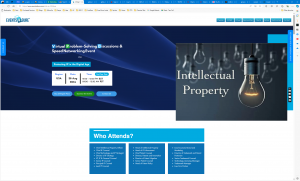
PatentPC Attorney Bao Tran Outlines Key Strategies for Medical Device Patent Protection at Life Sciences Patent Network
PatentPC logo
PatentPC Attorney Bao Tran Outlines Key Strategies for Medical Device Patent Protection at Life Sciences Patent Network North America Fall 2024
SAN FRANCISCO, CA, UNITED STATES, October 16, 2024 /EINPresswire.com/ -- PatentPC, a leading intellectual property law firm, today released insights from attorney Bao Tran on effective patent strategies for the medical device industry. Drawing from extensive experience in the field, Tran highlights critical considerations for companies seeking to protect their medical technology innovations.
"The medical device sector presents unique challenges and opportunities when it comes to intellectual property protection," said Tran. "A well-crafted patent strategy is essential for companies to safeguard their innovations and maintain a competitive edge in this rapidly evolving industry."
Key points from Tran's analysis include:
Diverse Product Categories Require Tailored Approaches
Tran emphasizes that "medtech" encompasses a broad range of devices with varying regulatory requirements and development timelines. Class I, II, and III medical devices each have distinct considerations that impact patent filing strategies.
"For simpler Class I devices with faster time-to-market, filing patents early in the development process often makes sense," Tran explains. "However, more complex Class III implants that require extensive clinical trials may benefit from delaying filings until the product design is more finalized."
He advises companies to carefully consider their specific product category and development timeline when crafting a patent strategy. A one-size-fits-all approach is rarely optimal in the diverse medtech landscape.
Balancing Early Protection and Design Evolution
A key challenge highlighted by Tran is striking the right balance between filing patents early to establish priority and waiting until designs are more mature.
"Early-stage medical device companies often face a dilemma," says Tran. "There's pressure to file patents quickly to protect core concepts and attract investors. But initial designs frequently evolve substantially during development."
He recommends a staged approach for many companies:
File broad provisional applications on core concepts early
File follow-up provisionals every few months to capture iterative improvements
Combine provisionals into a comprehensive non-provisional application after 12 months
"This allows companies to establish early priority dates while also incorporating the latest design iterations," Tran explains. "It provides flexibility as products evolve without incurring the full costs of multiple non-provisional filings."
Protecting Hardware and Software Innovations
As medical devices increasingly incorporate sophisticated software and data analytics, Tran stresses the importance of protecting both hardware and software innovations.
"Modern medical devices often rely on complex algorithms and data processing to enhance functionality," he notes. "Companies need to think beyond just patenting physical components."
Key areas to consider for software-related patent filings include:
Novel algorithms for data analysis or device control
User interface designs that enhance usability
Methods for securely transmitting and storing patient data
AI/machine learning applications in diagnostics or treatment
Tran cautions that software patents require careful drafting to overcome potential subject matter eligibility challenges. "Framing software innovations in terms of technical improvements to the medical device itself can help establish patentability," he advises.
Leveraging Design Patents for Consumer-Facing Devices
For medical devices used directly by patients, Tran highlights the value of design patents in addition to utility patents.
"Design patents can be a cost-effective way to protect the distinctive appearance of wearable devices, at-home diagnostic tools, and other consumer-facing medical products," he explains. "They create an additional barrier to direct copying by competitors."
Tran notes that design patents are particularly valuable for products where the user interface and ergonomics are key differentiators in the market.
Addressing Manufacturing Trade Secrets
While patents are the primary form of IP protection for most medical devices, Tran points out that manufacturing trade secrets can also play an important role - particularly for high-volume products.
"For devices produced in the millions of units, proprietary manufacturing techniques can provide a significant competitive advantage," he says. "Companies should implement robust trade secret protection protocols for sensitive manufacturing know-how that may not be appropriate for patent filings."
This may include specialized equipment designs, process parameters, and quality control methods that enable high-precision, high-volume production.
Navigating the Challenges of Software and Data Protection
As medical devices become increasingly software-driven and data-centric, Tran emphasizes several key considerations:
Open Source Software Audits: "It's critical for medical device companies to carefully audit their software for any open source components," Tran advises. "Certain open source licenses could force companies to release proprietary code, creating major IP risks."
He recommends implementing clear policies on open source usage and conducting regular audits, especially before major financing rounds or M&A activities.
Data Ownership and Access: "As devices collect more patient data, companies need to carefully consider data ownership, access rights, and monetization strategies," says Tran. "These issues should be addressed proactively in customer agreements and collaboration contracts."
He notes that while patient data typically belongs to healthcare providers, companies may be able to negotiate access to de-identified data for algorithm improvement and product development.
Balancing Patent Protection and Trade Secret Strategies: "For complex software algorithms, companies face a tradeoff between patent protection and trade secret strategies," Tran explains. "Patents provide stronger legal protection but require public disclosure. Trade secrets avoid disclosure but rely on maintaining secrecy."
He advises companies to carefully weigh the pros and cons for each software innovation, considering factors like:
Ease of reverse engineering
Expected lifetime of the technology
Ability to detect infringement
Importance to the core product offering
Collaboration Agreements with Research Institutions
Many medical device innovations emerge from academic research, creating both opportunities and challenges for commercialization. Tran offers guidance on navigating collaborations with universities and hospitals:
Narrow the Scope: "When collaborating with academic institutions, try to narrow the scope of joint research to non-core areas," Tran advises. "This reduces the risk of disputes over ownership of critical IP."
He suggests focusing collaborations on potential new applications or incremental improvements rather than fundamental technology development.
Address Data Access: "Clearly define data access and usage rights in collaboration agreements," says Tran. "Ensure the company has sufficient rights to utilize clinical data for product development and regulatory submissions."
Manage Publication Rights: "Academic researchers typically want to publish results quickly, while companies may prefer to delay disclosure until patent applications are filed," Tran notes. "Negotiate reasonable publication timelines that balance both parties' interests."
In-Licensing to Jumpstart Development: "For early-stage companies, in-licensing academic technology can provide a valuable starting point," Tran explains. "It can help attract funding and accelerate development timelines."
He cautions companies to carefully evaluate the scope and limitations of in-licensed IP to ensure alignment with long-term product plans.
Coordinating Patent, Regulatory, and Reimbursement Strategies
Tran emphasizes the importance of aligning patent, regulatory, and reimbursement strategies for medical devices:
Consistent Messaging: "Ensure consistent messaging across patent applications, FDA submissions, and reimbursement requests," Tran advises. "While the framing may differ, the core claims about the device's novelty and benefits should align."
He recommends regular communication between IP, regulatory, and market access teams to maintain consistency.
Highlight Distinctions Appropriately: "When seeking patents or new reimbursement codes, focus on distinguishing your device from alternatives," says Tran. "For FDA submissions, emphasize similarities to predicate devices while still noting improvements."
This nuanced approach requires careful coordination but is essential for navigating the complex medtech landscape.
Leverage Regulatory Submissions: "Information disclosed in regulatory submissions can inform and strengthen patent applications," Tran notes. "Ensure your patent team has access to regulatory filings to incorporate supporting data and examples."
Managing Global Patent Strategies
For medical device companies targeting international markets, Tran offers guidance on global patent strategies:
Prioritize Key Markets: "Focus patent filings on markets with the strongest commercial potential and robust IP enforcement," Tran advises. "For many medtech companies, this typically includes the US, Europe, China, and Japan."
Consider Regional Differences: "Tailor patent strategies to account for differences in patentability standards and enforcement climates across jurisdictions," says Tran. He notes that software and diagnostic method patents face greater eligibility challenges in Europe compared to the US.
Leverage Patent Prosecution Highways: "Utilize patent prosecution highway programs to accelerate examination in multiple countries," Tran recommends. "This can lead to faster, more consistent patent grants globally."
Monitor Competitor Filings: "Regularly monitor competitor patent filings in key markets to identify potential threats and inform R&D direction," advises Tran. He suggests setting up automated alerts for relevant patent classifications and competitor names.
Addressing Unique Challenges of Capital Equipment
For companies developing large-scale medical devices like imaging systems, Tran highlights several unique patent considerations:
Long Development Cycles: "The extended R&D timelines for complex capital equipment create challenges for patent strategy," Tran explains. "Initial concept patents may be filed years before the final product design is determined."
He recommends maintaining pending applications throughout the development process to capture evolving designs and new innovations.
Modular Patenting Approach: "Break down complex systems into discrete subsystems and components for patenting," advises Tran. "This allows for more targeted protection of key innovations and greater flexibility as designs evolve."
Protect Ancillary Innovations: "Don't overlook patenting opportunities in areas like installation, calibration, and maintenance," says Tran. "These can provide valuable differentiation for capital equipment with long lifespans."
"Effective patent strategy is critical for success in the competitive medical device industry," Tran concludes. "By taking a holistic approach that considers regulatory, reimbursement, and commercial factors alongside IP protection, companies can build robust patent portfolios that drive long-term value."
He emphasizes that patent strategies should be regularly reviewed and adjusted as products evolve and market conditions change. "In the dynamic medtech landscape, a static patent strategy quickly becomes outdated. Successful companies treat IP strategy as an ongoing process aligned with overall business objectives."
About PatentPC
PatentPC is a leading intellectual property law firm specializing in patent prosecution and strategy for technology companies. With deep expertise in medical devices, software, and other cutting-edge fields, PatentPC helps clients build and leverage IP portfolios that drive business success.
Mary Kimani
PatentPC
+1 800-234-3032
email us here
Visit us on social media:
Facebook
X
LinkedIn
YouTube
Other
Use Technology to Cut IP costs
Distribution channels: Business & Economy, Culture, Society & Lifestyle, Law, Science, Technology
Legal Disclaimer:
EIN Presswire provides this news content "as is" without warranty of any kind. We do not accept any responsibility or liability for the accuracy, content, images, videos, licenses, completeness, legality, or reliability of the information contained in this article. If you have any complaints or copyright issues related to this article, kindly contact the author above.
Submit your press release



